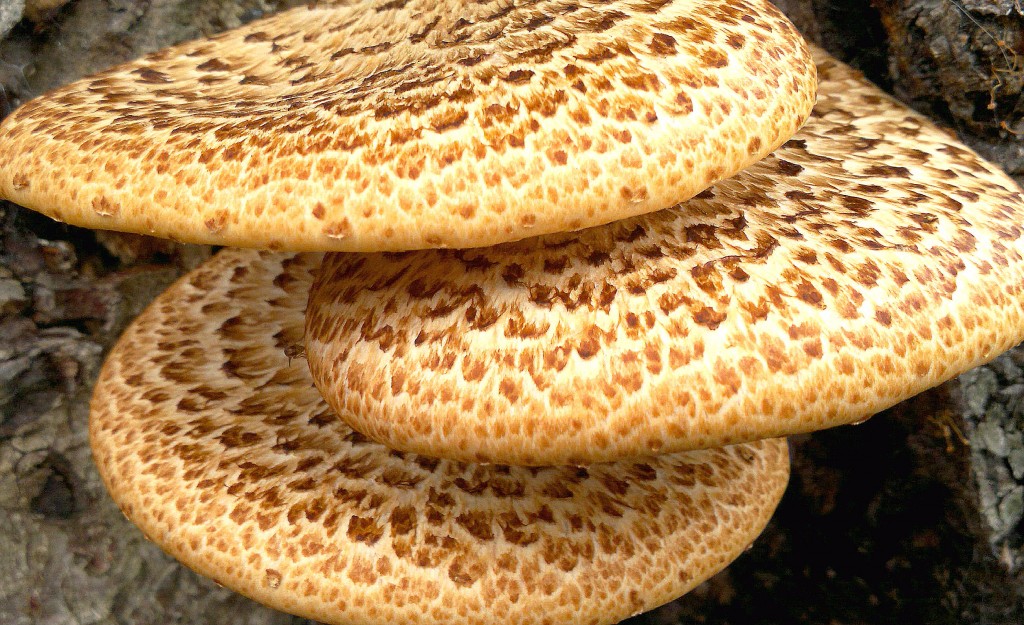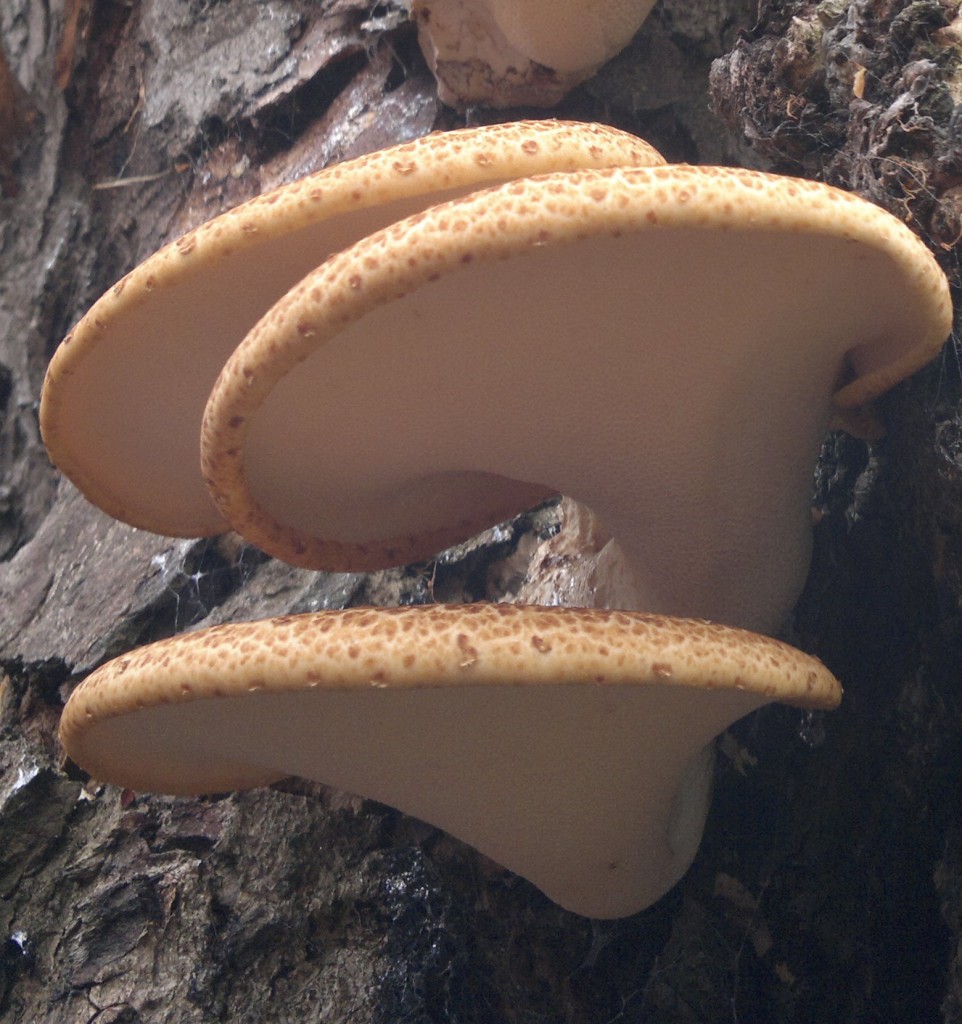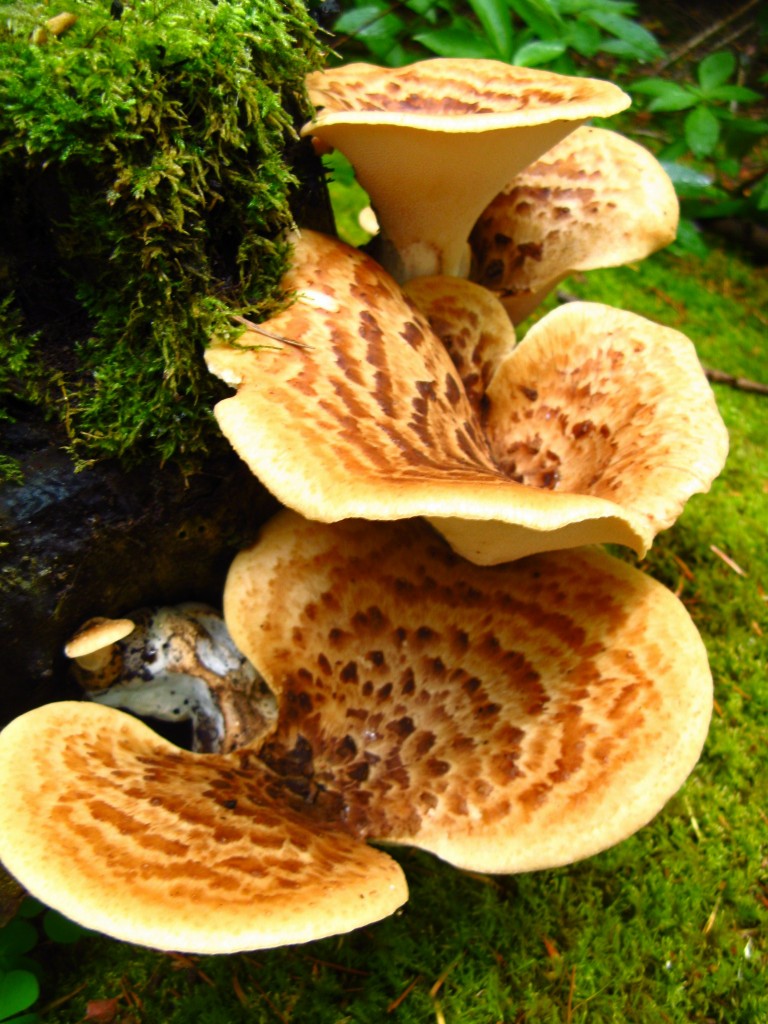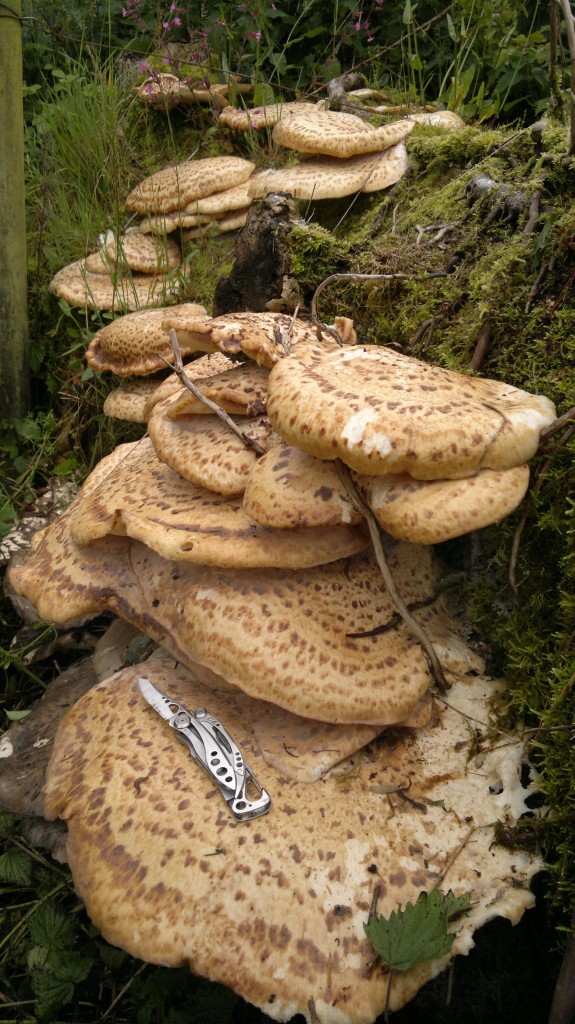Dryad’s Saddle – Edibility, Identification, Distribution
Cerioporus squamosus
(Until recently known as Polyporus squamosus)
AKA Pheasant mushroom, Pheasant back
- Edibility – 1/5 – young succulent specimens only – you really need to catch them early before before they get tough and indigestible. That normally means before the brackets are more than about 6cm across. Be on the ball from the start of May because they grow really fast! If you can catch them in their youthful prime, and cook them correctly, I’d rate them up to 3/5.
- Identification – 4/5 – Cream to ochre brackets up to 70cm diameter with concentric brown fibrous scales on top, not dissimilar to the plumage on some game birds, broad (1-3mm) pores below. Partial stem.
- Ecological role – Parasitic and saprophytic on broad leaved trees, part of nature’s recycling process. Home, nursery and food to some fungal gnats.
- Considerate Harvesting – These are extremely beautiful mushrooms, often better to admire than to eat. Leave some for others (including invertebrates) to admire/use, and to spread their spores, and further help with renewing woodlands
- Distribution – 4/5 – Common and easy to spot.
- Season – April – August
- Habitat – growing as a parasite on dead and dying deciduous trees, especially elm, beech and sycamore.
I have harshly rated this beautiful fungi for edibility due to the difficulty of catching it in its youthful prime. If you do find a young ‘un, consider it a potential 2 or even 3/5, so long as you slice it thinly before searing quick and hot in a mixture of butter and oil. I’ve never had any joy with any over 8cm diameter. Even babies can be pretty tough tough and hard to digest, especially when slow cooked. If you do miss the small ones, just stand back and enjoy the beautiful colours, textures and shapes of these woodland sculptures! When they grow on fallen trees, I can easily imagine them as seats for arboreal sprites…
Also, have a smell of the pores. They remind me very strongly of watermelon! Alas, I have never quite managed to extract this flavour in useable form.
Finely chopping then mixing with 15% by weight of sea salt then leaving to ferment for 3 months makes a passable garum (umami-heavy seasoning/sauce, in the manner of nam pla or fish sauce) after straining. For more information on how to do this, see my post on razor clams, and making fish garum. The garum technique can be a bit hit-and-miss, but this simpler technique below is consistently good:
Can you spot the still-edible tot in this picture?
Dryad’s saddles can be really prolific on some trees…




28 Comments
Do you ever find them on grass? I’ve come across a mushroom I haven’t been able to identify, it looks like a dryads saddle, but is well away from any trees (the closest being a horse chestnut about 10-15m away)
Hi Matthew,
Sorry, think I missed your question for a few months! Check out giant/blackening polypore. Often grows from roots.
Otherwise i’d need to see a picture – here is my guidance on submitting ID requests: http://www.gallowaywildfoods.com/?page_id=1239
I have thinly sliced this mushroom from small to large size (no maggots) and have enjoyed it. I butter fry it until the edges are crispy brown. My four boys love it too. I think it is a great find large and small. The large ones are great for the way you can slice them. I agree the taste is not strong, but as a belly filler I have no complaints.
hello I do not think that what you have is dyrads saddle if you want to know what it is please find a trustworthy mushroom identifier cause a app like picturethis may not work why i think you don’t have dyrads saddel is cause dyrads saddel is a shelf mushroom but i would check to see if there is wood possibly underground sorry i am 12 tho but i do tons of resarch on mushrooms and plants cause i am a forger
Those are all Dryad’s Saddle and are all attached to wood. Keep researching before eating what you are foraging!
Nick was answering the question about finding Dryad’s saddle in the grass (no, you can’t), not referencing the pics above. Nick’s answer was perfect.
Had seen this mushroom before many times when hunting morels, indeed it does smell like cucumbers and is easy enough to identify. The taste of the young specimens is wonderful, highly recommended.
Hi I stumbled across this bracket Fungi while wondering around the other day. Can anyone confirm if this Dryads Saddle grows on Gorse bush’s cause the species I found is all growing on gorse.
I know there are not many other Fungi that they can be mixed up with, but for everything I have read nobody mentions about the particular species growing on Gorse bush. I’m new to this got a couple of books but I want to be one hundred percent certain before I eat any Fungi.
Hi, Sorry, hard to know what you are talking about without a picture. I have never seen DS growing on gorse, and find it hard to imagine it on such narrow trunks. Do post some pics on my FB or twitter and i’ll have a look.
Mark.
Hi Mark thanks for your reply, I am sorry for asking after reading the above post I now know its not a very good idea to ask someone online. After doing some more research online I’ve found it does grow on Gorse bush. http://www.geograph.org.uk/photo/4012081
I also found a cluster of three Puffballs all together, I’ll get some better pictures showing both parts of the Fungi.
Thanks very much.
Can you dry these to make arangments,like to paint on them etc.
You could try, but I expect they would shrivel up a bit. Better to use hard “woody” brackets for this, like hoof fungus or ganoderma spp.
~6 cm is a conservative size by which to limit harvesting. If they’re larger, it becomes more necessary to use ~2″ from the edge, much like a chicken of the woods would be trimmed for use. Yes, potentially more fibrous than a baby 6 cm fruit, but still edible (and still tasty) within limits.
Hey my friend I have mushroom very similar to this is there any chance you would Identify it for me if I send u a picture just wana make sure before I try to eat it. Thanks all the best
I can take a look if you post it to one of my social media feeds. There is no facility to post photos here. 🙂
Mark
Any size Dryad’s Saddle can be dried and turned into a flour to be added to baked goods, stews, and soups.
These seem easily identified, but are there any poisonous lookalikes? Thanks!
Not really, especially at the time of year, and provided you focus on the ID features, obvs!
Hi, wanted to know when making mushrumami is it 5% or 15% salt ? You mention both these quantities.
Thanks 🙂
Hi Lisa, They were two different recipes – I’ve clarified the text above now.
Mark
It is a complete shame that you have scored Dryad Saddles so poorly on edibility. As long as you pick smaller mushrooms they are quite delicious and tender.
Hi
Dryads saddle, how to gauge edibility of specimens. It’s all about the length of the pores. I have had them as small as my hand and inedible and as big as dinner plates totally edible. It cannot be guaged by size! It they are growing strongly and have a BIG food source they grow in huge clusters upto 4 or 5 kg and edible. As they mature the pores grow down and become spongy and the bracket toughens. When the pore length gets around 3mm the stem is toughening but about half the outer bracket is still edible. How do you know what’s edible and what’s not in a toughening bracket. A knife will easily slice like butter what is still edible, if you finding it a little difficult it will be a little chewy. You can also harvest it close to it toughening and leave it for few days in the fridge and loose more of it. It continues to toughen after harvesting.
Hi
Collected some today but by the time we arrived home they’d gone dark brown and not too enticing! Is this normal?
Given the time of year, and the blackening, are you sure you didn’t pick blackening polypore (aka giant polypore, mirapilus giganteus)?
In central Maine I have only found pheasant back growing from decaying elm trees. There are plenty due to Dutch elm disease. I never the woody elm taste pleasing. I keep sampling and hoping that someday I will develop a taste for them. They are easy to find and abundant every year.
Harvested some dryad saddle yesterday.
Cooking tonight.
Plentiful now in se Michigan forests.
Have been collecting for over 30 years on my property in Armada mi USA wait till a bit larger than you specify and slice outer edges till a sharp knife meets some resistance then stop even the real large ones have tender outer edges.
I have dryads growing in my yard is it possible to start a small farm for them do I need a specific kind of wood or can I splinter the wood they are growing on, will that help spread spores??